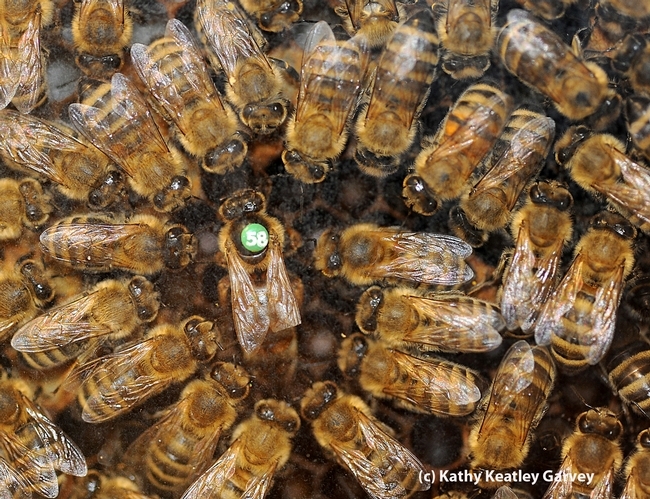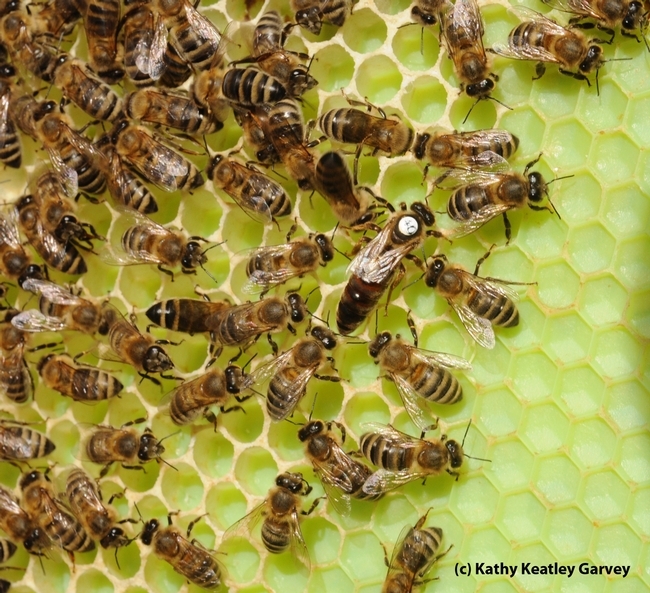If a queen bee were to celebrate Mother's Day (and she won't because she's too busy laying eggs), what a crowded festivity that would be.
Bee breeder-geneticist Susan Cobey of Washington State University, former manager of the Harry H.Laidlaw Jr. Honey Bee Research Facility at UC Davis, describes the queen as an "egg-laying machine."
"She's the mother of all the bees in the hive," saysCobey, who studied at UC Davis with Harry Hyde Laidlaw Jr., (1907-2003), "the father of honey bee genetics." During the peak season, the queen can lay up to 2000 eggs a day. That amounts to about 50,000 to 80,000 workers (sterile females) and 1000 to 2000 drones (males) in the hive.
On her maiden flight, the queen bee mates with some 12 to 25 drones in mid-air and then she heads back to the hive to lay eggs for the rest of her life, says Cobey, internationally renowned for her Carniolan bees and classes on instrumental insemination and bee breeding (stock improvement).
Yes, every bee in the hive has the same mother. Not so with the fathers.
In his book, The Honey Bee Hobbyist, the Care and Keeping of Bees, Norman "Norm" Gary, UC Davis emeritus professor of apiculture, writes: "All bees in a colony develop from eggs laid by the queen, so they all share the same mother. All bees in a colony develop from eggs laid by the queen, so they all share the same mother. But as a population, they typically have around 15 fathers."
As Gary points out: "The queen bee has no control over the drones that inseminate her. (The virgin queen) mates while flying, never inside the hive."
It's a matriarchal society. The girls (worker bees) do all the work; they serve as nurse maids, nannies, royal attendants, builders, architects, foragers, dancers, honey tenders, pollen packers, propolis or "glue" specialists, air conditioning and heating technicians, guards, and undertakers. So their abbreviated life (during the summer the life span of a worker bee is only four to six weeks) is not surprising. The drones, or males, serve only a reproductive function. Once they they mate, they die.
Honey bee geneticist Robert E. Page Jr., distinguished emeritus professor of entomology at UC Davis (and emeritus provost, Arizona State University) studied with Laidlaw for his doctorate at UC Davis. He pays tribute to Laidlaw in his book, The Art of the Bee: Shaping the Environment from Landscapes to Societies.
In Chapter Nine, "The Song of the Queen," Page reprinted a poem by E. B. White (Dec. 15, The New Yorker) objecting to instrumental insemination. White opined in the poem that the queen bee should "mate with whatever drone" she encounters.
Page reprinted Laidlaw's response, published in the San Francisco Chronicle, which said in part:
Her offspring slave throughout the day,
They feed her children as best they may
They would like to see a moment
Directed toward stock improvement.
If you're interested in bees and beekeeping, or just curious about these amazing superorganisms, these books read well on Mother's Day...and any other day.
Attached Images:

